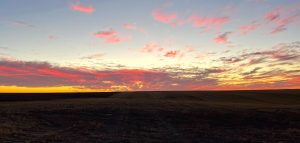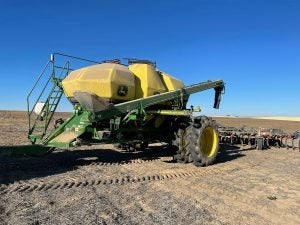So you want to be a farmer? Modern agriculture gets blamed for a lot of environmental problems. But in those same conversations, they are also expected to be the solution. Farming is a traditional occupation with modern expectations. So what’s a modern farmer to do?
Derek Schafer of Schafer Ranch — located between Ritzville and Lind in Washington state — works the balance between tradition and innovation every day, growing a rotation of wheat, canola, and dry peas.
I spent an afternoon with Schafer and saw what he was up to. For a working farm, it’s impeccably clean. No machinery hangs around unless it has a purpose. No junk. Just an orderly and efficient work space. His shop was cleaner than my house (which is not saying much), and his employees take as much care with the space and equipment as he does.
And you have never seen a sunset so beautiful. The views go on for miles.

I asked Schafer what a typical day looks like for him. Any farmer will tell you it’s literally never the same day to day, and this operation was no different.
Like most farmers, Schafer starts his day early. He’s seeding during the time of my visit, so that means a roughly 6 a.m. start. First there’s fueling and servicing the equipment needed for the day’s activities, several hours in the tractor seeding, maybe some time in the office, and maybe some repairs to end the day.
But who knows what’s going to happen. It could rain, and that puts a stop to any seeding that was planned. Then he has to plan out re-seeding in the fields already seeded. Maybe a rig breaks down and needs to be repaired? Like any job, things can go wrong, and often do.
A good farmer makes adjustments and gets on with the work.
But how does what he does differ from what his predecessors did? He grows on land that has been in production for 130 years — for reference, that’s several decades before the Dust Bowl in the 1930s. In that time, there has been a lot of technological advances. Just the shift from horse-drawn plows to tractors made farming more efficient. Now the tractors are self-propelled and have multiple functions. Technology has allowed one person to accomplish the work of multiple people and in a smaller amount of time. There’s GPS and other data that helps farmers keep track of progress, along with equipment that does the seeding and the fertilizing in the same pass.
Schafer practices no-till production, so that saves a pass of the tractor and helps keep the soil in good health.
The more we learn about the impacts that agriculture can have on the environment, the quicker farmers move to make adjustments. In fact, the farmers that work at multiple levels of the government have seen to it that the Conservation Reserve Program is worked into many operations. Schafer himself said that 15 percent of his acreage is in the program.
Why? What does that do? Well, it gives unproductive, or marginal, land a chance to fix itself by putting roots, crop residue, and organic matter back into the earth. It’s basically cover-cropping for conservation. The added soil structure from this program prevents runoff from rain and snow melt, builds the soil and makes it productive and available to either add to the crop rotation or allow for a naturalized area that would otherwise be barren, unhealthy, and not useful to anyone or anything.

Other ways Schafer has streamlined and improved his process is to use fewer inputs, and more environmentally healthy strategies, like his weed-control methods, which includes the use of a self-propelled tractor with a camera to pinpoint precise areas where there is weed pressure. It then identifies the exact weed and uses a specific herbicide to spray it (versus a broad spectrum herbicide that can inadvertently damage surrounding or off-target vegetation). This has reduced the farm’s herbicide use overall by 90 percent. This method also preserves soil health since, after all, healthy soil produces healthy crops.
I asked Schafer what he thought his greatest achievement in agriculture has been, and he told me embracing change. And he, and other modern farmers, have to. Many changes that farmers have made are geared toward improving the environmental impact of agriculture. There’s so much misinformation out there that makes agriculture the bad guy in environmental health. But Schafer contends that farmers are the best stewards of the land.
“We are the caretakers of our generation and want someone else to have the opportunities we’ve had. We are really careful about taking care of land, improving it, and soil health,” Schafer said. “Farmers are the number one environmentalist because they are in touch with their own land; in touch and [know] what it needs. The last thing we want to do is hurt it because it provides for us.”
And if you remember nothing else from this article, remember that.
Farm on.
Brianna Scott is a veteran farmer who lives in Eastern Washington while earning her Master’s of Science in Agriculture from Washington State University. She is active in the veteran ag community and raises poultry and livestock while growing a large market garden.



